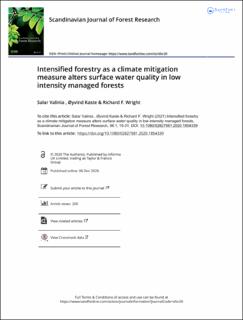| dc.contributor.author | Valinia, Salar | |
| dc.contributor.author | Kaste, Øyvind | |
| dc.contributor.author | Wright, Richard F. | |
| dc.date.accessioned | 2021-07-15T14:03:10Z | |
| dc.date.available | 2021-07-15T14:03:10Z | |
| dc.date.created | 2020-12-23T10:55:30Z | |
| dc.date.issued | 2020 | |
| dc.identifier.citation | Scandinavian Journal of Forest Research. 2020, 36 (1), 15-31. | en_US |
| dc.identifier.issn | 0282-7581 | |
| dc.identifier.uri | https://hdl.handle.net/11250/2764567 | |
| dc.description.abstract | Climate change has led to a focus on forest management techniques to increase carbon (C) sequestration as a mitigation measure. Fertilisation and increased removal of biomass have been proposed. But these and other forest practices may have undesirable effects on surface water quality. In naturally acid-sensitive areas such as much of Fennoscandia a concern is acidification due to acid deposition in combination with forest practices that increase the removal of base cations and leaching of nitrate (NO3). Here we apply the biogeochemical model MAGIC to the coniferous-forested catchment at Birkenes, southernmost Norway, to simulate the effects of forest fertilisation and harvest on soil and streamwater. The model was calibrated to the 40-year data for water quality, soil and vegetation and then used to simulate fertilisation and clearcutting of the mature forest by either conventional stem-only harvest (SOH) or whole-tree harvest (WTH). The 5 – 10-year pulse of NO3 following clearcut was larger with SOH than WTH. WTH causes larger acidification of surface water relative to SOH, due to greater depletion of base cations, N and C from the soil. The use of forestry as a climate mitigation measure should take into consideration the potential effects on soil and surface water quality. | en_US |
| dc.language.iso | eng | en_US |
| dc.publisher | Taylor & Francis | en_US |
| dc.rights | Attribution-NonCommercial-NoDerivatives 4.0 Internasjonal | * |
| dc.rights.uri | http://creativecommons.org/licenses/by-nc-nd/4.0/deed.no | * |
| dc.title | Intensified forestry as a climate mitigation measure alters surface water quality in low intensity managed forests | en_US |
| dc.type | Peer reviewed | en_US |
| dc.type | Journal article | en_US |
| dc.description.version | publishedVersion | en_US |
| dc.rights.holder | © 2020 The Author(s) | en_US |
| dc.source.pagenumber | 15-31 | en_US |
| dc.source.volume | 31 | en_US |
| dc.source.journal | Scandinavian Journal of Forest Research | en_US |
| dc.identifier.doi | 10.1080/02827581.2020.1854339 | |
| dc.identifier.cristin | 1863036 | |
| cristin.ispublished | true | |
| cristin.fulltext | original | |
| cristin.qualitycode | 1 | |

